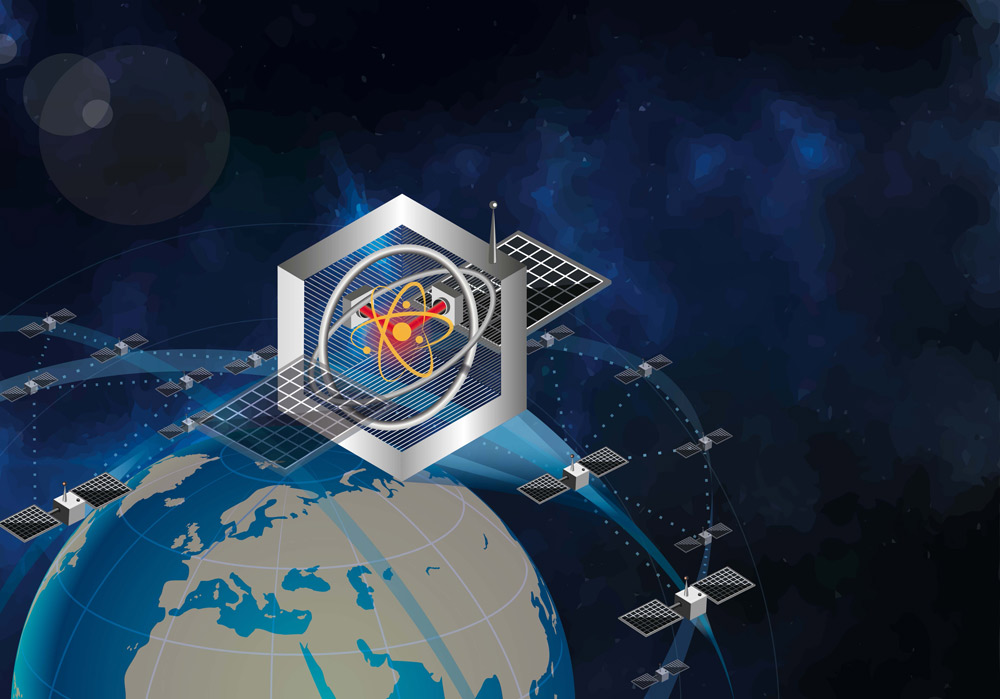News: Optoelectronics
1 September 2022
TRUMPF develops VCSELs for quantum-based altitude gyroscope sensor
TRUMPF Photonic Components GmbH of Ulm, Germany (part of the TRUMPF Group) – which manufactures vertical-cavity surface-emitting lasers (VCSELs) and photodiodes for the consumer electronics, datacoms, industrial sensing, heating and automotive markets – has developed a high-power, single-mode VCSEL to be implemented in an altitude gyroscope sensor suitable for use in space.
In a few years time the satellite with the quantum-based gyroscope should fly into space to generate highly precise attitude determination. The first satellite controlled by quantum technology is scheduled to be launched in 2027. The core component of the sensor will be a VCSEL light source. As miniaturization and robustness are essential for the application, the very small and durable VCSELs are suited to the job. Compared with existing laser solutions, VCSELs can be supplied several orders of magnitude smaller and at significantly lower cost. The newly developed single-mode VCSEL will come with stable polarization and a very narrow bandwidth to address the high precision needed in the quantum sensor.

“It’s great to be part of the subsidy project, and to combine various fields of expertise, push for innovations and strengthen Germany as photonics hub,” comments CEO Berthold Schmidt. The sensors enable the satellites to be aligned with each other with high precision and thus enable a high-speed connection for data communication. “We can’t wait to see our VCSEL integrated into a mini satellite, to support worldwide high-quality data communication and to improve the availability of Internet connections, especially in remote regions,” he adds.
How VCSELs support quantum applications
Quantum technology guarantees long-term measurement stability, provides high performance in a small space, and reduces weight. This not only allows satellites to hold their position precisely for years but also supports other spectroscopic applications and atomic clocks.
TRUMPF is developing a single-mode VCSEL emitting at a wavelength of 795nm with 10mW of output power. This is ten times higher than the laser power that this technology was able to offer in the past.
The VCSEL technology also delivers the required stability over a wide range of temperatures and robustness demanded by this space application. The breakthrough in compactness and cost enabled by VCSEL technology will also open up more applications in mass markets, it is expected. Highly precise gyroscopes can be used in industry, logistics or even in autonomously driving cars.
Combining forces within the subsidy project
The subsidy project QYRO has an overall development budget of about €28m and is supported by Germany’s Federal Ministry of Education and Research (BMBF).
TRUMPF Photonic Components is working closely with the Ferdinand-Braun-Institut, Leibniz-Institut für Höchstfrequenztechnik (FBH) of Berlin, Germany. Together with this institute, TRUMPF is jointly developing robust VCSELs with high spectral purity that also meet the demands of quantum technology and space. Another TRUMPF subsidiary based in Berlin will integrate the VCSEL component into a robust, miniaturized TO package with additional optics and temperature stabilization. TRUMPF brings to the table its assembly and automation technology experise. Overall, there are five project partners, each bringing their own specialization, such as Bosch, that is developing a miniaturized, space-compatible measuring cell. The German Aerospace Center (DLR) will ensure the suitability for space within the QYRO project and is responsible for transporting the satellite into space. The quantum technology start-up Q.ANT is leading the development partnership and assembling the various components of the sensor.









